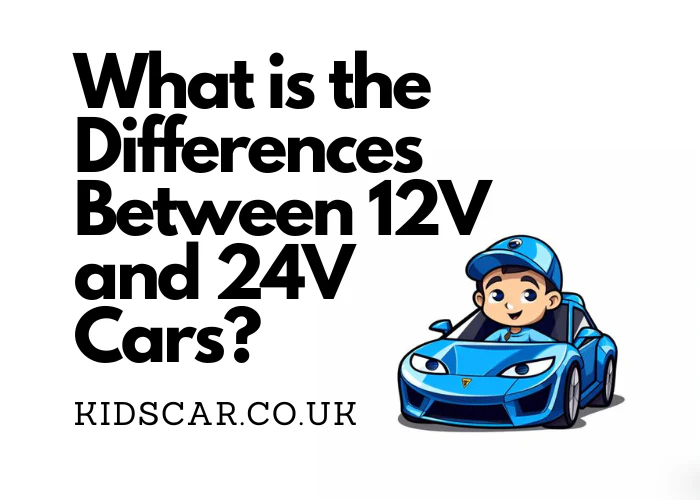12V electric cars are suitable for younger children (ages 3-6) and travel at a top speed of about 4 mph, while 24V cars are designed for older, more experienced children (over 6 years) and can reach speeds up to 6 mph.
Recommended Voltages for Kids Electric Cars by Age Group
| Age Group | Recommended Voltage |
|---|---|
| 1-Year-Old | 12V |
| 2-Year-Old | 12V |
| 3 to 4-Year-Olds | 12-24v |
| 5 to 6-Year-Olds | 24V |
| 7-Year-Olds and Above | 36V |
Expanding on this, 12V cars are tailored for safety and ease of use, perfect for beginners who are still developing basic motor skills and coordination. These cars are typically more budget-friendly and work best on flat, smooth surfaces. However, they do require more frequent charging. In contrast, 24V cars cater to older kids seeking a more thrilling experience. They offer enhanced performance on various terrains, including rough and uneven surfaces, and come with a longer battery life. Despite these advantages, they are more expensive and necessitate careful supervision due to their increased speed and power.
How Do the Speed and Power of 12V and 24V Kids Cars Compare?
The speed and power of a 12V kids car are limited to ensure safety for younger drivers, with a top speed of around 4 mph. In contrast, a 24V car can travel faster, up to 6 mph, providing a more powerful and adventurous experience for older children.
The lower speed of 12V cars is a deliberate design choice to match the abilities and safety requirements of younger children. These cars are excellent for developing confidence in driving and coordination skills. On the other hand, the increased speed and power of 24V cars make them suitable for children who already have some experience with ride-on toys and can handle the additional challenge responsibly.
What Should Parents Consider When Choosing Between 12V and 24V Cars?
Parents should consider the child's age, experience, and the driving environment when choosing between a 12V and a 24V car. Additionally, factors like safety features, budget, and the car's maintenance requirements are important.
For younger or less experienced children, a 12V car is a safer choice, offering a controlled environment to learn and play. These cars are also more affordable and simpler to maintain. However, if the child is older maybe 4-7 years + and more experienced, and seeking a more adventurous ride, a 24V car is preferable. It's essential to ensure that the chosen car matches the child's ability to handle it safely, especially considering the faster speed and greater power of 24V cars.
What Are the Developmental Benefits of 12V and 24V Kids Cars?
12V cars support the development of basic motor skills and hand-eye coordination in younger children, along with introducing them to fundamental driving concepts. In contrast, 24V cars challenge older children to refine these skills further and develop advanced coordination and problem-solving abilities.
The controlled speed and simpler operation of 12V cars make them an excellent tool for young children to safely explore and learn. For older children, the increased capabilities of 24V cars provide an opportunity to test and enhance their driving skills, decision-making, and independence.
Which Voltage Is Best for My Child?
Determining the best voltage for a kids car depends on the child's age, experience, and the desired use of the car. For younger, less experienced drivers, a 12V car offers a safe and enjoyable introduction to motorized vehicles. For older, more adventurous kids, a 24V car provides a more exciting and challenging experience. Parents should carefully consider these factors along with safety, budget, and maintenance needs to make the best choice for their child.
What Volt Should a 1-Year-Old Use?
For a 1-year-old, it's recommended to use a 6 to 12V kids car. These cars are much slower and safer, ideal for toddlers who are just starting to explore ride-on toys. Read our guide to the best ride on cars for 1 year old.
What Volt Should a 2-Year-Old Use?
For a 2-year-old, a 6V car is still the most appropriate. These vehicles offer a gentle introduction to motorised toys, with safety features tailored for very young children.
Is a 12V Car Suitable for a 4-Year-Old?
Yes, a 12V car is suitable for a 4-year-old. At this age, children usually have developed enough motor skills and coordination to safely handle the slightly higher speed and power of a 12V car.
Can a 5-Year-Old Handle a 24V Car?
It's generally not recommended for a 5-year-old to use a 24V car. These cars are more powerful and faster, better suited for children over 6 years old who have more experience with ride-on toys.
What's the Best Option for a 7-Year-Old?
A 24V car is often the best option for a 7-year-old. Kids at this age can usually handle the increased power and speed, making these cars an exciting choice for more adventurous and experienced young drivers.
Should I Choose a 12V or 24V Car for an 8-Year-Old?
For an 8-year-old, a 24V car is typically more suitable. By this age, children are often ready for the more challenging and thrilling experience that a 24V car offers.

